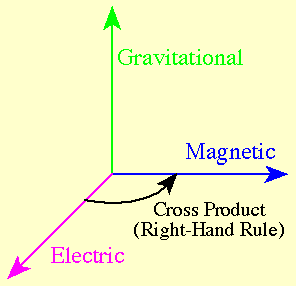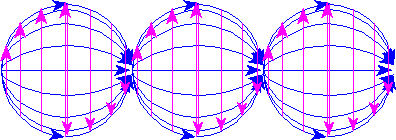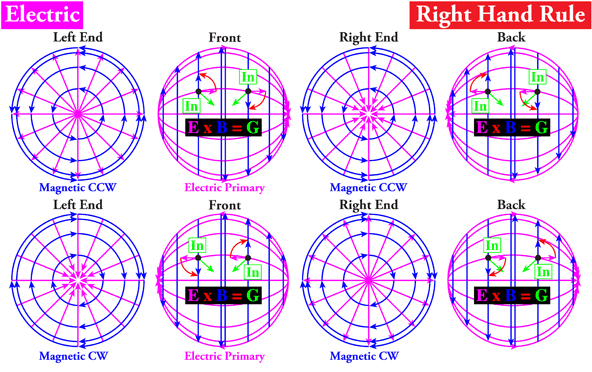If you research information on gravity -- given its importance -- you would find a surprising lack of information on it. I have not purchased a single book dedicated specifically to the subject because the books I have seen have given nothing new or interesting on the topic.
Here is something new, dramatic, and -- in my opinion -- very interesting on gravity:

In this graphical representation of the equation:
![]()
the "G" symbol represents the gravitational force field vector. It does not represent the small "g" in the equation F = mg. It does represent the gravitational constant "G".
What implication does this equation have for traditional physics? First, and this is a big implication, gravity is transported by photons.
In physics, physicists will typically talk about photons as being waves of light, or packets of light. Photons transmit the electric and magnetic fields. The fields are typically drawn like in the following graphic:

One field, say the electric, is orient ated vibrating up and down. The other field, in this case the magnetic, is orientated to vibrate sideways. There is no gravitational field in this representation.
When Einstein predicted that photons could be bent by gravity, it was a huge prediction in the history of physics. It was what truly catapulted him into the limelight when, during and eclipse of the sun, the positions of stars were observed to shift slightly, agreeing with his prediction. Photons can be bent by gravity. Fact. But why? How does the photon above interact with gravity?
I can not visualize how the photon represented in the graphic above can stay harmonic through great distances. It does not look harmonic, even though I admit my drawing is not very good. I visualize photons as moving as in the following graphic.

In this drawing, the electric field follows the a spherical pattern, from left to right and is represented with blue arrows. The magenta arrows counter-rotate around the spheres and represent the magnetic fields. But what is missing? Gravity! It is well known that the electric and magnetic fields interact at a right angle to create the Poynting Vector. But if the equation is reformulated, as shown above, it is found that the gravitational force vector always points to the center of the spherical waves. In other words the electric and magnetic fields "pivot" around the gravitational field. I have shown this in many other locations at this web site. Below is a graphic of one quadrant of Table B that shows the gravitational fields.

In all instances, from every point on the spherical surface, the cross product always points to the center of the sphere.
I think of gravity as being like a small "suction" pointing to the center of every elementary particle. This "suction" is caused by the electric and magnetic fields rotating around in the spherical pattern.
Photons of light interact with gravity because gravity is transmitted by light.
Physicists predict gravitons are the long wavelength waves that transmit the gravitational field. I do not believe they exist because I believe gravity is transmitted by photons.
The gravitational constant is a mathematical constant in Newton's law of gravity.

The "F" stands force the gravitational force. The "m1" and "m2" stand for the masses of the two objects that are gravitationally attracting each other. The "r2" is the squared value of the radius that separates the two object's centers of mass. The value of this constant is believed by physicists as constant. I do not. I believe this value is only valid in earth's orbit. I believe it is even has a slight error the closer you get to the sun, or the further you get from the sun.
When you learn about Einstein's Relativity, you learn that as a mass moves faster, its mass dilates or increases in value. This increased mass is what would be used in Newton's equation above.
Using the Ball-of-Light Particle Model, as a particle's velocity is increased -- with respect to an expanding sphere of light -- then the electric and magnetic fields in the particle would be induced to higher values according to traditional electromagnetic theory. What would be different using the Ball-of-Light Particle Model is the cross product of the electric and magnetic fields, that points to the center of the particle -- graivity -- would also increase.
According to the Ball-of-Light Particle Model, as a particle's velocity increases with respect to an expanding sphere of light, its mass and gravitational field increases accordingly. This alone has a tremendous impact on astrophysics.
The Ball-of-Light Particle Model's implications for astronomy are tremendous: